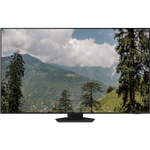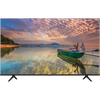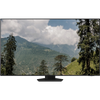A comparison of specs, key information, reviews, and best pricing from top retailers
Last updated -- hours ago | Report incorrect information
What we think

The PerfectRec TV team Learn more
Updated January 10, 2024·
If you value overall picture quality, particularly in dark rooms, and have a higher budget, the Samsung QN85B may be preferable. It offers superior contrast, local dimming for deeper blacks, and performs well in bright rooms, making it a versatile choice for various lighting conditions and content types, like movies and gaming. On the other hand, the Hisense A6H is more budget-friendly. While it performs acceptably across different types of content, it’s not as well-suited for dark rooms or for viewers seeking high brightness levels. The A6H would be suitable if you prioritize saving money and still need a satisfactory all-around TV, but the picture quality won't match that of the Samsung QN85B. Give Feedback
this description is based on the product variant with some specs and product variant with some specs. At the time of writing, the variant with some specs cost some dollars and the variant with some specs cost some dollars.
Advantages of the Hisense A6H (LCD)
- The Hisense A6H (LCD) has no clear advantages over the Samsung QN85B (LCD).
Advantages of the Samsung QN85B (LCD)
- Excellent for bright room
- Good for dark room
- Very good for gaming
- Good for movies & TV
- Good for sports
- Very good for news, talk, & other TV
- Very good for cartoons & animation
- Very good for use as monitor
- Very good motion processing
- Very good reflections
Key differences
Picture Quality
5.2


7.5
3.35/10
CONTRAST
5.64/10
6.1/10
COLOR VOLUME SCORE
7.5/10
LED
PANEL TYPE
miniLED FALD
IPS
PANEL SUB-TYPE
IPS
The Samsung QN85B (LCD) has good picture quality, while the Hisense A6H (LCD) has poor picture quality.
Movies & TV
4.9


7.3
3.35/10
CONTRAST
5.64/10
5.4/10
BLACK UNIFORMITY
5.7/10
7.5/10
UPSCALING
7.5/10
Yes
HDR10 SUPPORT
Yes
Yes
HDR10+ SUPPORT
Yes
Yes
DOLBY VISION SUPPORT
No
The Samsung QN85B (LCD) is good for movies & TV, while the Hisense A6H (LCD) is poor.
The Samsung QN85B delivers a good movie-watching experience due to its high contrast, effective local dimming, and better black uniformity, which are crucial for depth and detail in darker scenes. In contrast, the Hisense A6H falls short in these areas, offering poorer contrast and local dimming, and weaker black uniformity, leading to a less immersive viewing experience, particularly in dark environments.
Sports
6.1


7.1
2.5/10
MOTION PROCESSING
8.0/10
60Hz
REFRESH RATE
120Hz
10.0/10
INPUT LAG SCORE
10.0/10
7.5/10
UPSCALING
7.5/10
5.5/10
SDR BRIGHTNESS SCORE
9.3/10
Yes
HLG SUPPORT
Yes
The Samsung QN85B (LCD) is good for sports, while the Hisense A6H (LCD) is only fair.
The Samsung QN85B is considered good for watching sports because it has a very good response time and excellent motion processing capabilities, which means action-packed scenes look smooth, and it also handles reflections very well, making it suitable for bright rooms. On the other hand, the Hisense A6H is considered fair for sports; it has a poor response time, which can lead to blurrier images during fast movements, and its motion processing isn't as refined.
Gaming
5.7


8.2
5.9/10
RESPONSE TIME SCORE
8.0/10
10.0/10
INPUT LAG SCORE
10.0/10
2.5/10
MOTION PROCESSING
8.0/10
0.0/100
GAMING LOCAL DIMMING
70.0/100
5.4/10
GAME HDR BRIGHTNESS SCORE
9.0/10
The Samsung QN85B (LCD) is very good for gaming, while the Hisense A6H (LCD) is poor.
The Hisense A6H has poor response time, meaning there can be more blur during fast-moving games, yet its input lag is rated best, which is favorable for gaming. Conversely, the Samsung QN85B has very good response time for clearer images in action-packed scenes and also shares the best rating for input lag, making it responsive and better for gaming overall.
Cartoons & Animation
5.7


8.0
5.9/10
COLOR GAMUT SCORE
7.2/10
6.1/10
COLOR VOLUME SCORE
7.5/10
5.5/10
SDR BRIGHTNESS SCORE
9.3/10
8.3/10
COLORS OUT OF THE BOX SCORE
7.9/10
7.7/10
GRAY UNIFORMITY
7.2/10
The Samsung QN85B (LCD) is very good for cartoons & animation, while the Hisense A6H (LCD) is poor.
The Samsung QN85B has better colors out of the box and a superior color gamut compared to the Hisense A6H, therefore, it displays cartoons and animations with more vivid and accurate colors, enhancing the viewing experience for this type of content.
News, Talk, & Other TV
5.8


8.2
5.5/10
SDR BRIGHTNESS SCORE
9.3/10
7.5/10
UPSCALING
7.5/10
The Samsung QN85B (LCD) is very good for news, talk, & other TV, while the Hisense A6H (LCD) is poor.
The Hisense A6H struggles with upscaling and has lower SDR brightness, which makes it less suitable for watching standard-definition content like news and talk shows; additionally, the colors out of the box, color gamut, and contrast are not optimal for such programming.
Bright Room
5.4


9.2
7.8/10
VIEWING ANGLE
7.5/10
5.5/10
SDR BRIGHTNESS SCORE
9.3/10
5.3/10
HDR BRIGHTNESS SCORE
8.9/10
6.0/10
REFLECTIONS SCORE
8.9/10
The Samsung QN85B (LCD) is excellent for bright room, while the Hisense A6H (LCD) is poor.
The Samsung QN85B performs excellently in bright rooms due to its higher SDR and HDR brightness along with better handling of reflections, making it ideal for well-lit environments. In contrast, the Hisense A6H has poorer brightness and fair reflection handling, which compromises its performance in bright rooms.
Cost
$650


$1,199
$0
$500
$1,000
$1,500
$2,000
The Hisense A6H (LCD) has a price of $650 and the Samsung QN85B (LCD) costs $1,199.

Let Us Help Find Your Perfect TV
Find your new TV
Give feedback
We’re constantly working to improve.
How the Hisense A6H (LCD) and the Samsung QN85B (LCD) compare to other TVs
Spec Comparison
| Hisense A6H (LCD) | Samsung QN85B (LCD) |
GENERAL | |||
|---|---|---|---|
| Price | |||
$650 | $1,199 | ||
Brand | |||
Brand | Hisense | Samsung | |
Release Date | |||
Release Date | April 3, 2022 | March 2, 2022 | |
Full name | |||
Full name | 65A6H | QN65QN85B | |
Screen Size | |||
Screen Size | 65" | 65" | |
Screen Resolution | |||
Screen Resolution | 4K | 4K | |
TV FEATURES | |||
|---|---|---|---|
Operating System | |||
Operating System | Google TV | Tizen | |
Sound Quality Score | |||
Sound Quality Score | 6.1/10 | 7.5/10 | |
NextGen Ready | |||
NextGen Ready | No | No | |
HDMI Ports | |||
HDMI Ports | 4 | 4 | |
Coax Ports | |||
Coax Ports | 1 | 1 | |
DISPLAY QUALITY SCORES | |||
|---|---|---|---|
Picture Quality Score | |||
Picture Quality Score | 5.3/10 | 7.6/10 | |
Bright Room Score | |||
Bright Room Score | 5.4/10 | 9.2/10 | |
Gaming Score | |||
Gaming Score | 5.8/10 | 8.3/10 | |
Movies & TV Score | |||
Movies & TV Score | 5/10 | 7.3/10 | |
Sports Score | |||
Sports Score | 6.1/10 | 7.2/10 | |
PHYSICAL | |||
|---|---|---|---|
Dimensions w/o Stand (H x W x D) | |||
Dimensions w/o Stand (H x W x D) | 32.8" x 57.2" x 2.9" | 32.6" x 56.9" x 1.1" | |
Dimensions with Stand (H x W) | |||
Dimensions with Stand (H x W) | 35.3" x 57.2" | 35.1" x 56.9" | |
Weight without Stand | |||
Weight without Stand | 36.4 lbs | 52.2 lbs | |
VESA Mount | |||
VESA Mount | 400 x 300 | 400x300 | |
DISPLAY | |||
|---|---|---|---|
Color Depth | |||
Color Depth | 10 bit | 10 bit | |
Black Frame Insertion | |||
Black Frame Insertion | No | Yes | |
Auto Low Latency Mode | |||
Auto Low Latency Mode | Yes | Yes | |
Contrast | |||
Contrast | 3.4/10 | 5.6/10 | |
Local Dimming | |||
Local Dimming | 2.5/10 | 8/10 | |
SOUND | |||
|---|---|---|---|
Speaker Setup | |||
Speaker Setup | 2.0 | 2.2.2 | |
Speaker Power | |||
Speaker Power | 28 W | 60 W | |
Dolby Atmos | |||
Dolby Atmos | Yes | Yes | |
DTS:X | |||
DTS:X | Yes | No | |
Shopping
Samsung QN85B (LCD)
See more
Dig into reviews and images
What Hi-Fi?
John Archer | February 2023
"Particularly key to this is the fact that black levels are unusually good, on a level we haven’t seen from any IPS TV before. Build quality is impressive too, with a gleaming silver metallic frame and stand, and enough heft to suggest plenty of quality innards. High dynamic range content jumps off the screen with enough luminosity and intensity to really sell what makes HDR special."
Get a great deal on the Hisense A6H (LCD) or the Samsung QN85B (LCD)
About Hisense
Hisense, a Chinese TV manufacturer, entered the US market in approximately 2011 and has since acquired TV divisions from various companies such as Toshiba, Sharp, Hitachi, and NEC. Currently ranking as the fourth largest vendor in terms of sales volume, Hisense aims to capture a wide range of TV budget segments. They offer exceptional value with TVs that often outperform their competitors at similar price points, making them a compelling choice for consumers. In the US, they use Google TV as their smart TV software which provides the largest app selection and a very modern user interface, however it is not as user friendly as the software from other vendors.
About Samsung
Samsung, a South Korean electronics manufacturer, holds the title of being the largest global TV vendor in terms of units sold. They offer a diverse lineup of TV products that cater to various budget ranges. A notable achievement in recent years is the development of Quantum Dots, a technology that enhances color reproduction, resulting in richer and more vibrant hues. Samsung TVs are well-regarded for their high manufacturing quality and user-friendly software, making them an excellent choice for consumers seeking an intuitive viewing experience.
Give feedback
We're constantly perfecting our model
TV guides you might be interested in
More comparisons for you
FAQs
FAQs about TVs
Why trust us
This information was produced and vetted by the PerfectRec TVs team. We are a product research and recommendation organization that meticulously reviews and evaluates the latest TV information and makes it digestible for you.
By the numbers
385
TVs evaluated
33,110
TVs stats compiled
21
Proprietary TVs ratings developed
121,830
Recommendations made
18,275
Consumer hours saved
About the TV team
Joe Golden, Ph.D
CEO and TVs Editor
Joe is an entrepreneur and lifelong electronics enthusiast with a Ph.D in Economics from the University of Michigan.
Jason Lew
Staff Expert & Software Engineer
Jason is a staff expert and software engineer that has been making laptop recommendations for 7 years and moderates one of the largest laptop subreddits.
Chandradeep Chowdhury
Staff Expert & Software Engineer
Chandradeep is a staff expert and software engineer and expert in televisions and monitors. He’s been making monitor recommendations for ten years.
Jaime Roldán
TVs Expert
Jaime is a Colombia-based TV expert. He is an electronics engineer with 8 years of experience in the telecom sector and has been making TV recommendations for 12 years.







